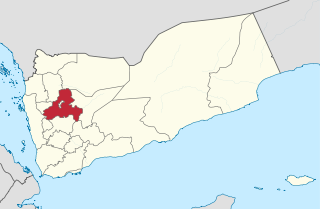
Yemen, officially the Republic of Yemen, is a country in West Asia. Located in southern Arabia, it borders Saudi Arabia to the north, Oman to the northeast, the Red Sea to the west, and the Indian Ocean to the south, sharing maritime borders with Eritrea, Djibouti and Somalia across the Horn of Africa. Covering roughly 528,000 square kilometres, with a coastline of approximately 2,000 kilometres, Yemen is the second largest country on the Arabian Peninsula. Sanaa is its constitutional capital and largest city. Yemen's estimated population is 34.7 million, mostly Arab Muslims. It is a member of the Arab League, the United Nations, the Non-Aligned Movement and the Organisation of Islamic Cooperation.

Sanaa, also spelled San'a' or Sana, is a governorate of Yemen. Its capital is Sanaa, which is also the national capital. However, the city of Sanaa is not part of the governorate but instead forms the separate governorate of Amanat Al-Asemah. The Governorate covers an area of 13,850 km2 (5,350 sq mi). As of 2004, the population was 2,918,379 inhabitants. Within this place is Jabal An-Nabi Shu'ayb or Jabal Hadhur, the highest mountain in the nation and the Arabian Peninsula.
Taj Hotels is a chain of luxury hotels and a subsidiary of the Indian Hotels Company Limited, headquartered in Mumbai, India. Incorporated by Jamsetji Tata in 1902, the company is a part of the Tata Group. The company employed over 20,000 people in the year 2010.

The cinema of Yemen is relatively obscure, but it has seen glimpses of influence and representation throughout the years. Since the 1920s, when expeditions from Europe arrived in Yemen, the country has been featured in various documentaries and travelogues. These early films introduced audiences to the landscapes, architecture, and culture of Yemen, providing a window into a world they might not have otherwise experienced.
Prostitution in Yemen is illegal and punishable by penalty from 3 years of prison to even death penalty but common especially in Aden and in the capital, Sana'a. UNAIDS estimate there are 54,000 prostitutes in the country. Many of these women have turned to prostitution because of poverty. Many are Ethiopian and Somali refugees.

Sanaa, officially the Sanaa Municipality, is the capital and largest city of Yemen. The city is the capital of the Sanaa Governorate but is not part of the governorate as it forms a separate administrative unit. According to the Yemeni constitution, Sanaa is the capital of the country, although the seat of the Yemeni government moved to Aden, the former capital of South Yemen, in the aftermath of the Houthi occupation. Aden was declared the temporary capital by then-president Abdrabbuh Mansur Hadi in March 2015.

Two explosions targeting tourists in Yemen took place in mid-March 2009. Sixteen South Korean tourists were in Shibam, Yemen, at the time of the first blast. Four Korean tourists alongside their local Yemeni guide were killed in the first attack on 15 March, while three more tourists were injured. Relatives of the victims were involved in the second blast on 18 March but the only fatality was the bomber. The initial attack followed numerous calls by members of the Al-Qaeda military network to attack visitors in the region.

ʿAmrān is a small city in western central Yemen. It is the capital of 'Amran Governorate, and was formerly part of Sana'a Governorate. It is located 52.9 kilometres (32.9 mi) by road northwest of the Yemeni capital of Sana'a, at the upper (southern) end of the al-Bawn plain. According to the 2004 census it had a population of 76,863, and an estimated population of 92,763 in 2013.
Topics related to Yemen include:

The Old City of Sanaʽa is a recognised UNESCO World Heritage Site in the Amanat Al Asimah Governorate, Yemen. As of 2003, the district had a population of 63,398 inhabitants. The old fortified city has been inhabited for more than 2,500 years and contains many intact architectural sites. The oldest, partially standing architectural structure in the Old City of Sanaʽa is Ghumdan Palace. The city was declared a World Heritage Site by the United Nations in 1986. Efforts are underway to preserve some of the oldest buildings some of which, such as the Samsarh and the Great Mosque of Sanaʽa, is more than 1,400 years old. Surrounded by ancient clay walls that stand 9–14 metres (30–46 ft) high, the Old City contains more than 100 mosques, 12 hammams (baths), and 6,500 houses. Many of the houses resemble ancient skyscrapers, reaching several stories high and topped with flat roofs. They are decorated with elaborate friezes and intricately carved frames and stained-glass windows.

The Great Mosque of Sana'a is an ancient mosque in Sana'a, Yemen, and one of the oldest mosques in the world. The mosque is said to have been founded in the early Islamic period, suggested to be in 633. While the precise date of construction is unknown, the earliest recorded renovations occurred under Caliph al-Walid I in the early 8th century, implying a possible earlier date of construction. The mosque was reportedly built in part from spolia from the Himyarite-era Ghumdan Palace and from the Axumite Christian Church of al-Qalis that formerly occupied the site. The Great Mosque is the largest and most notable of over one hundred mosques in the Old City of Sana’a.
The mainly Quaternary Harra of Arhab is the northernmost, historically active volcanic field in Yemen. Also known as the "Sana'a-'Amran volcanic field", or simply the "Sana'a volcanic field", it has erupted in ancient times.

The 2015 Sana'a mosque bombings were four suicide attacks targeting two mosques on 20 March 2015 in Sana'a, Yemen.
The following is a timeline of the history of the city of Sana'a, Yemen.

The Yemen Gate or Gate of Yemen is the main gate of Sana's old fortified wall, on the southern extremity of the walled city. Its current appearance dates to the 17th century, having been designed by Sam the son of Noah. Today, it is the most ornate of the gates of Sana's Old City. Passengers travelling southward, en route to Ma'bar and Dhamar, would depart from this gate.

The Islamic State – Yemen Province is a branch of the militant Islamist group Islamic State (IS), active in Yemen. IS announced the group's formation on 13 November 2014.

The Mosque of the Dome of the Mahdi or Al-Mahdi Mosque is one of the historical mosques in the historic old city of Sana'a, Yemen. It forms a part of UNESCO World Heritage Site Old City of Sana'a. It is located in the Al-Kareem Al-Mahdi neighborhood in the western Sarar district. It was built in 1651 by the order of Imam Mahdi Abbas bin Mansour. The tomb was built after the death of Imam Mahdi Abbas in 1768.
On 24 September 2015, a double suicide bombing was carried out by Islamic State at a mosque in Sana'a, Yemen, killing at least 25 people.












